History of UCSF, Part 3
Previous: 1860s-1950s | 1960s-1980s
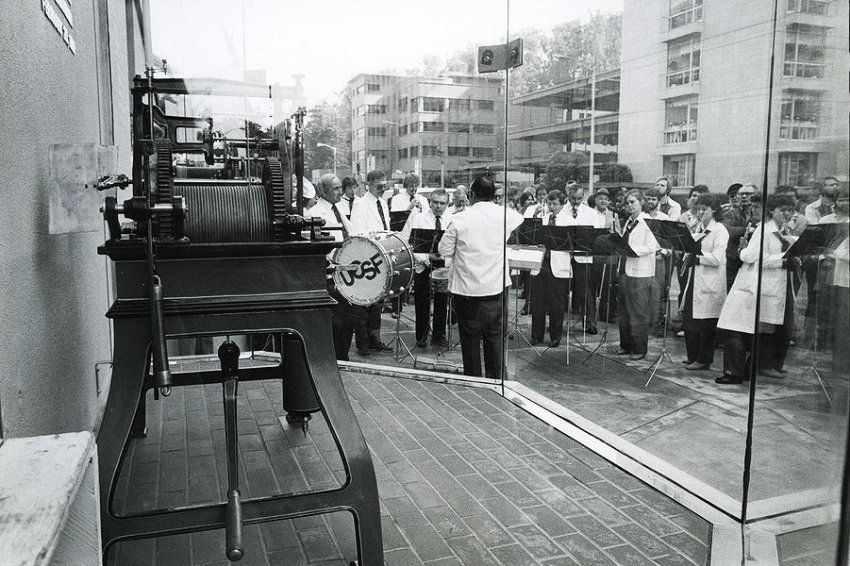
The UCSF Marching Band gathers at the Founders Clock on Parnassus Avenue to celebrate Founders Day 1982.
Experiencing Explosive Changes
In 1982, Julius R. Krevans, MD, became UCSF’s fifth chancellor. A distinguished physician and educator, Krevans’ professional career was devoted to the academic community. He played an important role nationally in developing public policy in medical education and the health sciences, and in advancing biomedical research.
During the 1980s and 1990s, UCSF already was one of the largest recipients of funding from the NIH and was experiencing explosive changes in science, further pushing the need for more research space. Some campus buildings were modernized and others were demolished to make way for construction of new facilities. But to meet the space demand, UCSF leaders also looked beyond Parnassus Heights.
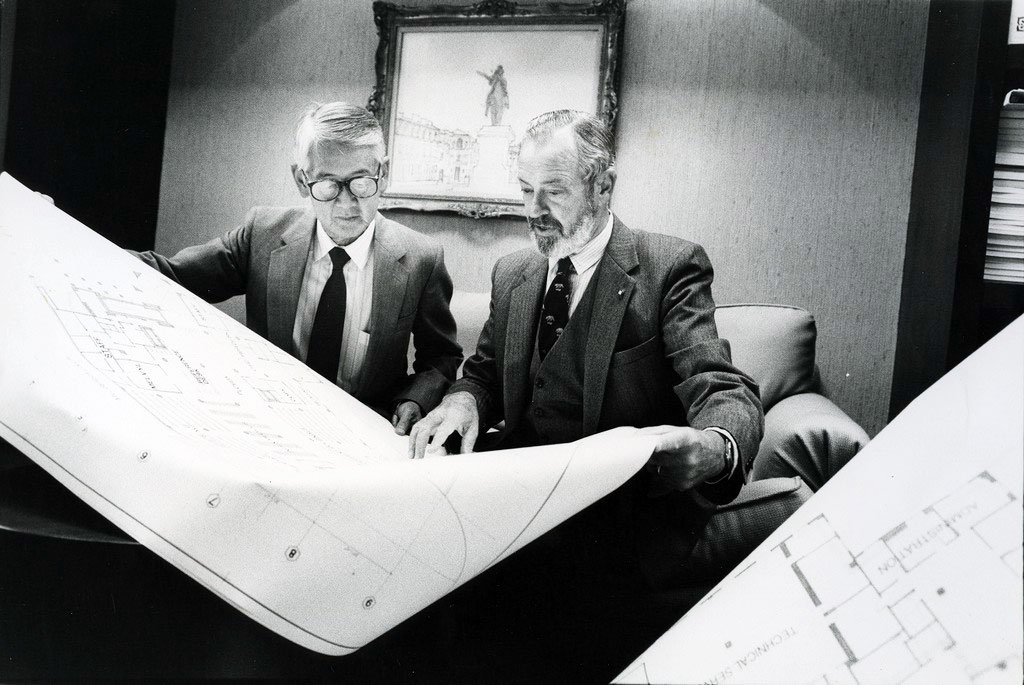
Chancellor Julius Krevans (right) looks at plans for the Kalmanovitz Library with landscape architect Hideo Sasaki in 1986. The library opened at the Parnassus Campus in 1990.
The Parnassus campus had opened the Marilyn Reed Lucia Child Care Center in 1978, and it continued to take on a new look with the opening of the Dental Clinics Building (1980); the new Joseph M. Long Hospital (1983), which was integrated with the existing Moffitt Hospital; Beckman Vision Center and Koret Vision Research Laboratory (1988); and Kalmanovitz Library (1990).
UCSF also began moving into other parts of the city.
In the Laurel Heights neighborhood, UCSF bought the Fireman’s Fund building in 1985, renaming it UCSF Laurel Heights. It was planned as a site for pharmacy school laboratory research and instruction, but neighborhood concerns about lab projects forced UCSF to consider other uses for the building. Over the next few years, the building developed as the home for academic desktop research, social and behavioral science departments, and administrative offices.
In the Western Addition, UCSF acquired Mount Zion Hospital in 1990, which became UCSF Medical Center at Mount Zion. It served as a second major clinical site and, in 1999, also became home to the first comprehensive cancer center in Northern California to have the National Cancer Institute designation. The center later was named the Helen Diller Family Comprehensive Cancer Center.
In 1993, Joseph M. Martin, MD, became UCSF’s sixth chancellor. He and Haile T. Debas, MD, dean of the UCSF School of Medicine, were instrumental in leading the discussion and merger with Stanford that created UCSF Stanford Health Care and in gaining critical community support for developing Mission Bay as the site for a second major campus for research and teaching.
The UCSF-Stanford merger was prompted by practical discussions between institutional leaders on how their medical schools and medical centers could share more and compete less in an era of declining federal funding and Medicare payments and of managed care. The talks led to a bold move to establish a merged health care system as a private, nonprofit corporation, keeping the medical schools and medical faculties independent. In 1997, UCSF Stanford Health Care began operating, but the goal of creating a single clinical entity with integrated service lines and increased clinical activity was not accomplished. The merger officially dissolved in spring 2000.
Developing Mission Bay
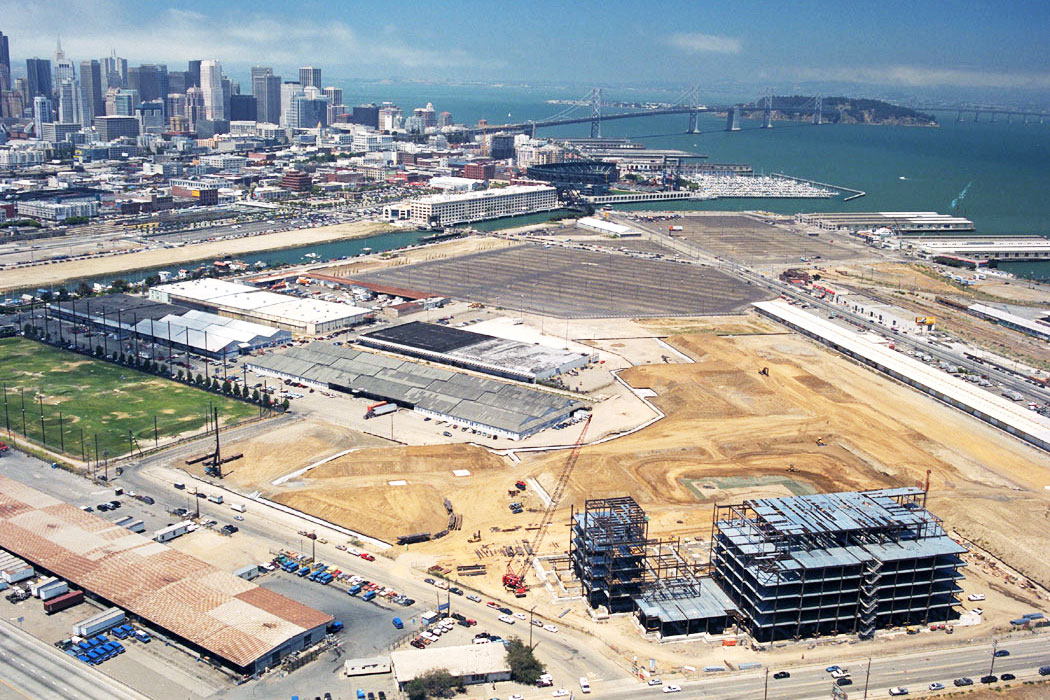
UCSF broke ground in 1999 for its new campus at Mission Bay, which stood for years as an abandoned railyard.
After a landmark deal struck by Bruce Spaulding, former vice chancellor of University Advancement and Planning at UCSF; Nelson Rising, chief executive officer of Catellus Development Corp.; and then-San Francisco Mayor Willie Brown, UCSF broke ground for the Mission Bay campus in 1999.
UCSF leaders spent several years evaluating different sites in all parts of the Bay Area and meeting with civic, business and community members before deciding to keep the second campus in San Francisco. Once occupied by old warehouses and rail yards, the initial Mission Bay campus land parcel included 42.4 acres: 29.2 acres donated by Catellus and 13.2 acres donated by the city of San Francisco. Later, an adjacent 14.5-acre parcel was added as the site for a new UCSF Medical Center, bringing the total campus to about 57 acres.
In 1997, Debas became UCSF’s seventh chancellor, agreeing to take the post for one year during the important period when the UCSF-Stanford merger and Mission Bay planning were advancing. He was an internationally renowned surgeon, scientist and teacher, and during his tenure, UCSF became one of the country’s leading centers for transplant surgery, training young surgeons, and basic and clinical research in surgery.
J. Michael Bishop, MD, a noted scientist who was a recipient of the 1989 Nobel Prize (with Harold Varmus, MD), became the eighth chancellor in 1998. He is recognized for steering UCSF through one of its most expansive periods of growth and achievement, including developing the Mission Bay campus from the ground up, establishing innovative research programs, and garnering record philanthropic support.
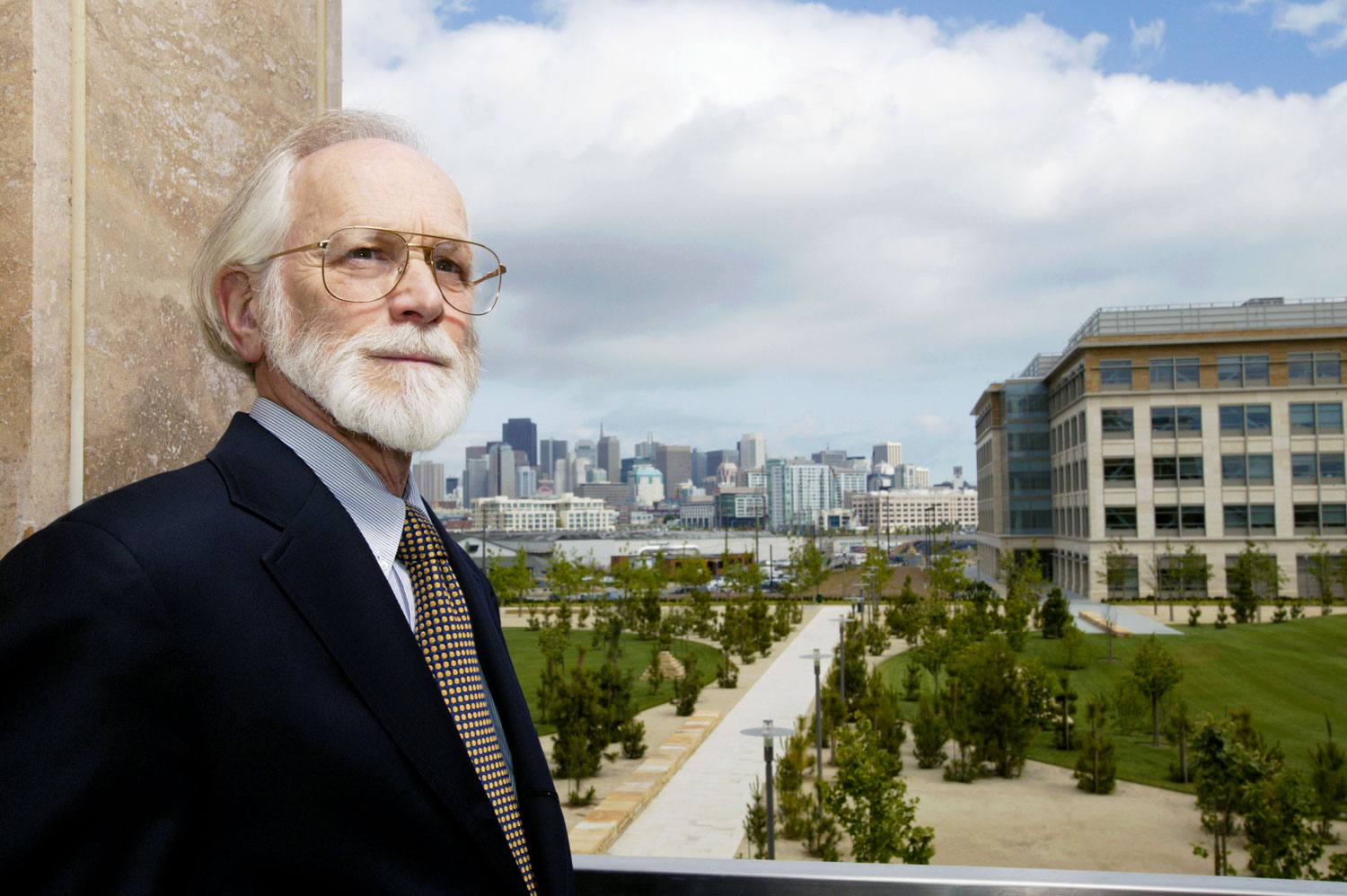
Chancellor J. Michael Bishop, MD, led UCSF during much of the initial development of the Mission Bay campus, which officially opened in 2003. Photo by Mark Estes
The Mission Bay campus became home to a vibrant community of scientists, scholars, students and staff. The first building, Genentech Hall, was occupied in 2003, followed by Arthur and Toni Rembe Rock Hall (2004), Byers Hall, William J. Rutter Center and Mission Bay Housing (2005), University Child Care Center (2006), and Helen Diller Family Cancer Research Building (2009), plus new quarters adjacent to the campus for the Orthopaedic Institute (2009).
As chancellor, Bishop, working with Eugene Washington, MD, executive vice chancellor and provost, unveiled the first comprehensive, campuswide strategic plan and laid the foundation for ongoing programs to enrich diversity and create a supportive work environment. UCSF also adopted a new mission: advancing health worldwide™.
Pursuing Continued Excellence
Susan Desmond-Hellmann, MD, MPH, became the first woman to lead UCSF when she was named chancellor in 2009 in the midst of the nation's worst economic downturn since the Great Depression. Under her leadership, UCSF successfully navigated the weak economic environment marked by ongoing cuts in state funding and outlined a plan for continued excellence by focusing on five priorities: patients and health, discovery, education, people and business.
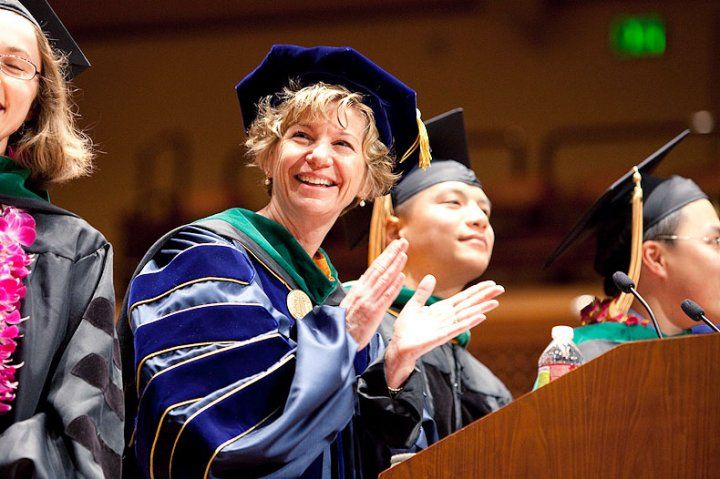
Susan Desmond-Hellmann, MD, MPH, at the 2010 School of Medicine commencememt ceremony, shortly after being named the first female chancellor of UCSF. Photo by Elisabeth Fall
Supporting her priorities was the opening of the Eli and Edythe Broad Center of Regeneration Medicine and Stem Cell Research at UCSF’s Parnassus campus in 2011. The center brings stem cell scientists together under one roof, enhancing their collaborative efforts in developing novel treatments for such diseases as diabetes, cardiovascular disease, Parkinson’s disease, HIV/AIDS and cancer.
In addition, the children’s hospital was renamed UCSF Benioff Children’s Hospital in honor of Marc and Lynne Benioff, who donated $100 million toward a new facility at Mission Bay designed specifically for children and their families.
UCSF continued to grow into its Mission Bay home, with the 2010 opening of the Smith Cardiovascular Research Building, the headquarters of the UCSF Cardiovascular Research Institute; the 2012 opening of the Sandler Neurosciences Center, home of many of UCSF's clinical and basic research programs in neuroscience; and the 2014 opening of the Global Health & Clinical Sciences Building, also known as Mission Hall.
Sam Hawgood, MBBS, a renowned neonatologist and dean of the UCSF School of Medicine, took the helm as UCSF's 10th chancellor in 2014, just as the University marked its 150th anniversary with a yearlong celebration that included a campuswide block party and a special Alumni Weekend that looked back through the decades of achievement.
In 2015, more than a decade of planning came to fruition with the grand opening of the new UCSF Medical Center at Mission Bay, a 289-bed integrated hospital complex and world-class facility serving children, women and cancer patients.
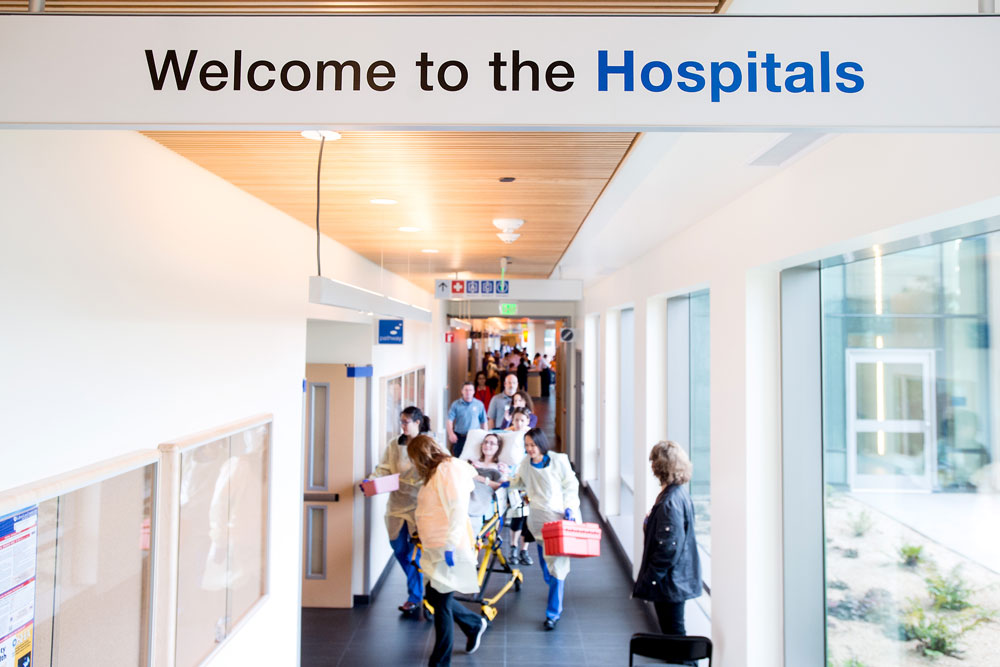
Pediatric patients are transported to the new UCSF Benioff Children's Hospital on the opening day of UCSF Medical Center at Mission Bay on Feb. 1, 2015. Photo by Noah Berger
On its opening day of Feb. 1, staff and faculty enlisted 40 ambulances and 100 emergency medical services personnel to safely transported 131 patients to the new hospitals from its Parnassus and Mount Zion campuses. The opening marked an exciting expansion for UCSF's world-class clinical enterprise, allowing Parnassus to upgrade its facilities to provide more specialized services for adult care and Mount Zion to become a hub for outpatient care.
In 2018, the Parnassus clinical complex was renamed the UCSF Helen Diller Medical Center at Parnassus Heights to recognize the Helen Diller Foundation's landmark $500 million commitment to support the planning of a new hospital, which is expected to open its doors to patients before 2030. The commitment brought total giving to UCSF by the Diller family to more than $1.15 billion, placing them among a handful of American philanthropists to have made commitments of $1 billion or more to a single U.S. academic institution.